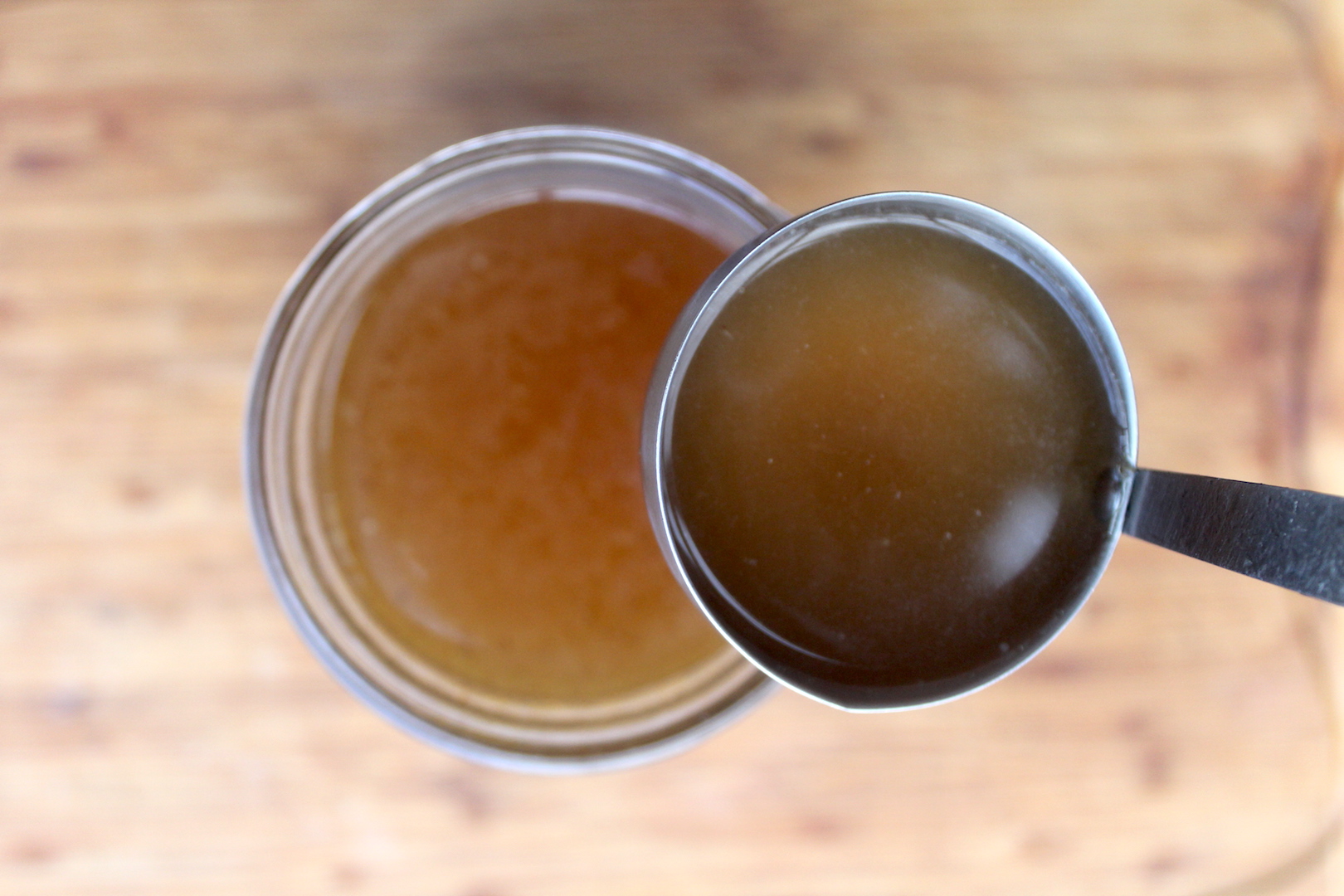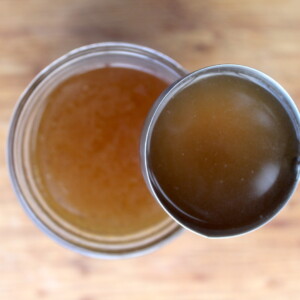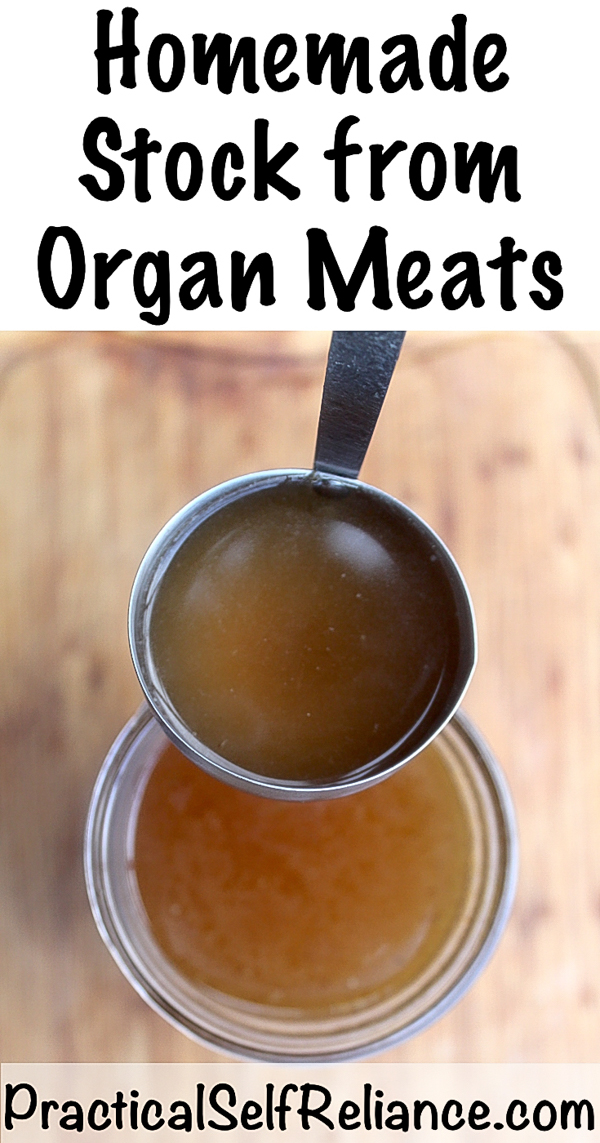Affiliate disclosure: This post may contain affiliate links. Please see our Privacy Policy.
Organ meat stock is a simple way to add bold flavor and extra nutrition to your pantry staples. By simmering liver, heart, kidneys, and other organ meats with bones and aromatics, you get a rich, umami-packed broth that elevates any savory dish. It’s a perfect example of nose-to-tail cooking that maximizes every part of the animal.

It’s easy to add depth and complexity to homemade stock simply by incorporating organ meats. While nose-to-tail eating is gaining popularity, many people still don’t know how to make the most of these nutrient-dense cuts—especially in everyday cooking. Adding organ meats to stock is a low-effort, high-reward way to get more value from your meat and create an incredibly flavorful broth that puts store-bought cartons to shame.
Even if you’re not a fan of eating liver or gizzards on their own, their rich flavor and umami compounds dissolve beautifully into a long-simmered stock. There’s a reason your holiday turkey still comes with a giblet bag—gravy just isn’t the same without it, and neither is the stock.
Why Make Stock with Organ Meats?
Bone broths get all the attention these days, but organ meat stock is in a class of its own. Bone broth is high in gelatin and collagen, but it can be thin in flavor without the support of organ meats. Adding liver, heart, kidneys, or other odd bits gives your broth a bold, savory depth that transforms simple soups, sauces, and gravies.
Even if you’re squeamish about cooking organ meats for dinner, stock is a great entry point. You don’t have to look at them on a plate or adjust to their texture. You just let them simmer, strain them out, and enjoy the flavor.
Try using organ meat stock in any recipe that calls for chicken or beef broth. It shines in hearty soups like lentil or black bean, in stews and sauces, and even in vegetable-based soups like butternut squash or mushroom bisque.
Which Organ Meats Work Well in Stock?
Liver – Packed with nutrients and flavor, liver is one of the best organ meats to add to stock. A small amount goes a long way, so start slow if you’re not used to the flavor.
Heart – The heart is a muscle meat and contributes a rich, meaty flavor. It helps balance the earthiness of other organ meats and enhances the stock’s overall body.
Gizzard – Found in poultry, the gizzard is a tough, muscular organ that tenderizes nicely when simmered for hours. Clean it well, removing the inner lining and any grit, before adding to stock.
Kidneys – These work especially well in beef or lamb stock. Give them a quick rinse and soak to mellow the flavor before simmering.
Testicles – If you process your own poultry, pork, or venison, you may come across these odd bits. Despite their appearance, they add a subtle seafood-like richness when cooked into stock.
How to Make Stock with Organ Meats
Making stock with organ meats follows the same general method as bone broth, with one optional extra step for clarity. If you want a cleaner, less cloudy stock, roast the organ meats in the oven before adding them to the stockpot. This also adds caramelized flavor that enhances the finished broth.
Once your organs are prepped, combine them with roasted bones, cooked meat scraps, and aromatic vegetables like onions, garlic, carrots, celery, and leeks. Cover everything with cold water, bring to a gentle simmer, and cook uncovered for 8 to 24 hours.
For the clearest result, avoid stirring while simmering, and skim off any foam or impurities during the first hour. When it’s finished, strain the stock first through a colander, then through a fine mesh sieve or cheesecloth.
You can use organ meat stock immediately, freeze it, or pressure can it for long-term storage.
Canning Organ Meat Stock
To preserve your stock for the shelf, use a pressure canner. Organ meat stock must be pressure canned to ensure safety.
- Method: Pressure Canning
- Pressure: 10 lbs (weighted gauge) or 11 lbs (dial gauge) at elevations under 1,000 ft
- Headspace: 1 inch
- Processing Time: 25 minutes for quarts and pints
Prepare your pressure canner with 2 inches of water. Heat jars and lids. Bring the strained stock back to a boil and ladle it into jars, leaving 1 inch headspace. Wipe rims, apply lids, and process according to your canner type and altitude.
Pressure Canning Altitude Adjustments
With pressure canning, the processing times stay the same at higher altitudes, but the pressures change. Here are the altitude adjustments for pressure canning:
For dial gauge pressure canners:
- 0 to 2,000 feet in elevation – 11 lbs pressure
- 2,001 to 4,000 feet in elevation – 12 lbs pressure
- 4,001 to 6,000 feet in elevation – 13 lbs pressure
- 6,001 to 8,000 feet in elevation – 14 lbs pressure
For weighted gauge pressure canners:
- 0 to 1,000 feet in elevation – 10 lbs pressure
- Above 1,000 feet – 15 lbs pressure
Using Organ Meat Stock
Organ meat stock can be used in place of any homemade or store-bought broth, but its deep flavor really shines in hearty, savory dishes.
Use it as a base for soups like lentil, black bean, French onion, or beef stew, or add it to slow-simmered sauces and gravies where richness matters. It also works beautifully for cooking grains—try using it to make rice, farro, or risotto for added depth.
If you’re easing into cooking with organ meats, this is the easiest way to enjoy their benefits without dealing with the texture—just pour, heat, and enjoy.

Organ Meat Stock
Equipment
- Pressure Canner
Ingredients
- 2 lbs Assorted organ meats, liver, heart, gizzards, kidneys, testicles
- 5 lbs bones, poultry, pork, beef, or mixed
- 3 medium onions, quartered
- 3 medium carrots, chopped
- 2 stalks celery, or 1 leek
- 1 bulb garlic, halved crosswise
- Optional: 1–2 bay leaves, thyme sprigs, parsley stems
- Water to cover
Instructions
- Preheat oven to 400°F. Roast organ meats and bones on a baking sheet for 30–40 minutes until browned (optional, but recommended for flavor and clarity).
- Transfer to a large stockpot and add onions, carrots, celery, garlic, and herbs. Cover with cold water, leaving a few inches at the top. Bring to a boil, then reduce heat and simmer uncovered for at least 8 hours, or up to 24.
- Skim foam as needed in the first hour. When done, strain through a colander, then a fine mesh sieve or cheesecloth. Chill or bring back to a boil for canning.
- If canning, ladle hot stock into hot jars, leaving 1 inch headspace. Wipe rims, apply lids, and process in a pressure canner for 25 minutes. Adjust pressure for altitude as needed. Once jars are cool and sealed, remove rings and store in a cool, dark place.
Notes















Have you ever used beef tongue in stock? I have all kinds of organs from buying 1/2 a cow that I don’t know how to use haha but would love to get any nutritional benefits they have.
Yes, I do use beef tongue in stock and it’s like using chicken feet in chicken stock, gives an extra rich gelatinous stock. You can also pressure can just beef tongue as well, and it comes out nice and tender for sandwiches. There’s a specific beef tongue canning recipe from the university of Wisconsin in this handout here: https://richland.extension.wisc.edu/files/2015/06/B3345-Canning-Meat-Wild-Game-Poultry-Fish-Safely.pdf
What cooking temperature and for how long do you roast the organ meat and bones?
You can roast them at about 400 degrees for 45 minutes to an hour or until they are cooked through.
Can I just put in some slices of liver when making bone broth from the start, I use an instant pot, so its done in much less time you put everything in and press the button? Will all the nutrients from the liver get into the broth? Ive only ever used bones.
That should work just fine.
When talking about liver, are you referring to beef or chicken or does it matter? Other places on the Internet have said liver would turn the broth flavor ‘off’ so I’m hesitant to try this. Should it be soaked in milk first to remove some of the strong flavor? I can’t stomach eating liver itself but would like to get the nutritional benefits of it.
Do you address this in another posting that I missed? Thank you.
It’s really a matter of personal taste, and though I don’t particularly like fresh liver, I love it in stock. We’ve used pork liver, chicken and duck and it’s all wonderful. Haven’t tried beef (yet), but I imagine it’d be fine in moderate amounts. I don’t do anything to prepare it ahead of time.
I have been buying pastured raised poultry for about six months. I save every bone and scrap to make broth. I have had several pouches of giblets in the freezer for quite some time. I didn’t really know what to do with them, but I could not bring myself to toss them. Even making some treats for the pets was better than waisting. Your post was the encouragement I need to toss them in the bone broth pot! Thank you
You’re very welcome. So glad you were able to find a use for them.